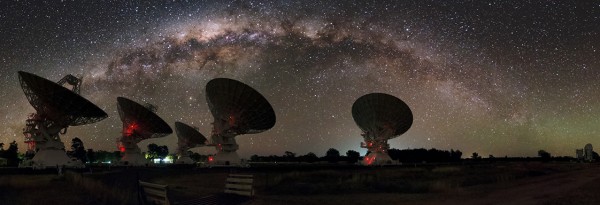By Ana Verayo, | November 18, 2016

The Australia Telescope Compact Array are radio telescopes designed to detect alien signals. (CSIRO)
Astronomers have revealed new information about the origins of a mysterious cosmic event known as "fast radio bursts," thanks to new data from the CSIRO's Parkes radio telescope in Australia.
Fast radio bursts are believed to have originated from the deep universe. They are made from high-energy radio wave pulses that can last for only milliseconds. The first FRB was detected in 2007 after scientists analyzed Parkes data in 2001, revealing the extremely difficult process of deciphering its real cosmic source.
Like Us on Facebook
Most astronomers suggest that these fast radio bursts originate from a very distant galaxy. However, some say that a more local source, such as somewhere in our Milky Way galaxy, could also be plausible.
In a new study led by astrophysicist Vikram Ravi from the California Institute of Technology, his team identified a probable FRB source as three candidate galaxies located in a small region of the sky. These galaxies are estimated to be more than 1,630 million light years from our solar system.
The new calculations made by Ravi's team also did not disregard the Milky Way as a source of the FRBs. There are also some theories also say that these powerful bursts of cosmic energies came from a young neutron star.
In this new study, the team studied FRB 150807 which was first detected in August 2015 using the CSIRO (Commonwealth Scientific and Industrial Research Organisation) Parkes radio telescope to observe a pulsar near our system.
This burst was recorded on the telescope receiver's 13 beams, which is a determining factor that can help astronomers identify the region of the sky that the FRB was emitted. The research team says that they are 95 percent certain that this FRB originates from a large galaxy which is hidden behind three other cosmic objects.
This new study also focuses on whether all FRBs originate from the same region in the universe and even if this latest FRB detected is the smallest ever recorded, it may or may not come from the same source population as the majority of FRBs.
Astronomers say that FRBs occur around 2,000 to 10,000 times a day, but only 18 have ever been detected and confirmed since these fast radio bursts only occur in just milliseconds.
This new study was published in the journal Science.
-
Use of Coronavirus Pandemic Drones Raises Privacy Concerns: Drones Spread Fear, Local Officials Say

-
Coronavirus Hampers The Delivery Of Lockheed Martin F-35 Stealth Fighters For 2020

-
Instagram Speeds Up Plans to Add Account Memorialization Feature Due to COVID-19 Deaths

-
NASA: Perseverance Plans to Bring 'Mars Rock' to Earth in 2031

-
600 Dead And 3,000 In The Hospital as Iranians Believed Drinking High-Concentrations of Alcohol Can Cure The Coronavirus

-
600 Dead And 3,000 In The Hospital as Iranians Believed Drinking High-Concentrations of Alcohol Can Cure The Coronavirus

-
COVID-19: Doctors, Nurses Use Virtual Reality to Learn New Skills in Treating Coronavirus Patients







